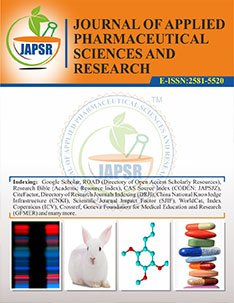ANTICONVULSANT ACTIVITY OF ISONICOTINIC ACID HYDRAZONE DERIVATIVES USING MES, scPTZ AND ROTOROD NEUROTOXICITY MODELS
Abstract
Epilepsy is a chronic neurological disorder, involving group of nerve cells, or neurons, in the brain. Many classes of antiepileptic
drugs are being prescribed and used by the stake holders but most of them are associated with serious side effects and toxicity. There is a strong
need of new antiepileptic molecules with less side effects and toxicity. Objective: A series of aryl acid hydrazones of Isonicotinic acid hydrazide
(RINH1 -RINH14) were synthesized and evaluated for Anticonvulsant activity. Material and Method: Compounds (RINH1 -RINH14) were
synthesized by refluxing Isonicotinic acid hydrazide with different substituted benzaldehydes/ substituted acetophenones in absolute ethanol.
Melting points of all synthesized compounds were monitored by open glass-capillary tube method on Digital Melting point apparatus and are
uncorrected. The synthesized compounds were tested for anticonvulsant potential using MES and scPTZ whereas neurotoxicity was determined
using Rotarod model. Result and Discussion: At 100mg/kg compound RINH10 have shown 29% protection at both 0.5hr and 4.0 time interval
.At 300mg/kg and 0.5 hr, compounds RINH4 and RINH10 showed 100% and 50 % protection respectively. Compounds RINH4 and RINH10 have
better anti MES activity proving that halogens have prominent contribution in Anticonvulsant activity. In scPTZ screen, all synthesized Acid
hydrazone (RINH1- RINH14 ) did not show any protection at 30, 100,300 mg/kg , at 0.5 hr and 4.0 hr duration .In rotorod test i.e neurotoxicity
screen, compound RINH5, RINH6 , RINH10 have shown toxicity. Conclusion: The synthesized new molecules were proved to be having
anticonvulsant activity with less signs of neurotoxicity.
Downloads
All the articles published in JAPSR are distributed under a creative commons license (CC BY-NC-SA 4.0)
Under this license, you are free to:
- Share- copy and redistribute the material in any medium or format for any purpose, even commercially.
- Adapt- remix, transform, and build upon the material for any purpose, even commercially.
The licensor cannot revoke these freedoms as long as you follow the license terms.
- Attribution — You must give appropriate credit , provide a link to the license, and indicate if changes were made . You may do so in any reasonable manner, but not in any way that suggests the licensor endorses you or your use.
- NonCommercial — You may not use the material for commercial purposes .
- ShareAlike — If you remix, transform, or build upon the material, you must distribute your contributions under the same license as the original.
- No additional restrictions — You may not apply legal terms or technological measures that legally restrict others from doing anything the license permits.
Copyright policy
The journal allows the author(s) to hold the copyright of their work. That means the authors do not need to transfer the copyright of their work to the journal. However, the authors grant JAPSR a license to publish the article and identify itself as the original publisher.
Licensing policy
The journal allows the author(s) to hold the copyright of their work. That means the authors do not need to transfer the copyright of their work to the journal. However, the authors grant JAPSR a license to publish the article and identify itself as the original publisher.






